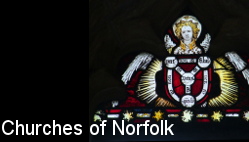
home I index I latest I glossary I introductions I e-mail I about this site
St Andrew, Blickling
Follow these journeys as they happen at Last Of England Twitter.
St Andrew, Blickling Blickling Hall is probably the grandest of the big Norfolk country houses, and one of the grandest in England. Largely constructed for Sir Henry Hobart in the 1620s on the site of its predecessor, it is perhaps the great Jacobean country house. Robert Lyminge, the architect, died on the job in 1628 and was buried in the churchyard here. The earlier house was the home of the home of the Dagworths and the Boleyns, and dated from the late 14th Century. If Lyminge could come back today he'd no doubt recognise the Hall, despite its additions in the late 18th Century. But perhaps he wouldn't recognise the church. St Andrew, which sits above the Aylsham road to the south-east of the Hall, has been largely rebuilt. As Pevsner observes, externally the church seems entirely Victorian, and partly indeed it is. The tower and porch are George Street's, while the chancel was rebuilt by William Butterfield in the 1850s. The result is perhaps a contrast with the gravity of the Hall, a somewhat austere and urban church which would not be out of place in a provincial town. And yet, it seems likely that no expense was spared. You enter through Street's south porch into a space which is rather dark and shadowy, as if designed for incense-led worship. Encaustic tiles lead your footsteps into the shadows, the building unfolding before you as you walk through it. What might stop you in your tracks though is the memorial at the west end of the nave to the eighth Marquess of Lothian, who paid for all this. He lies with his curly hair and beard guarded by life-size angels (or, at least, what one assumes is the life-size of an angel). George Frederick Watts, a sculptor perhaps best known for his public works, was the artist. As Mortlock pointed out, considering that he was buried elsewhere it is a somewhat overstated reminder. The font appears to be 15th Century, but it is surely entirely recut. You turn east and Hardman's glass in the east window is a beacon in the high chancel. Pevsner notes that it was exhibited in Paris before its installation. It was commissioned by Butterfield with an explicit request for bold colours. As you walk towards it you reach Blickling's collection of brass memorials which are mostly set at the east end of the nave before the chancel steps. Two of them are particularly memorable. Sir Nicholas Dagworth was the original purchaser of the Blickling estate and the commissioner of the Hall before the current one. In his outstanding Country Church Monuments, CB Newham notes that Dagworth had a successful career as both a soldier and a diplomat under both Edward III and Richard II, and spent most of his time overseas. His large full-figure brass is surrounded by a border which has been partly restored. Beside him is the memorial to Anne Astley, who died in 1512. She holds two swaddled babies. She died giving birth to twins, and as Newham observes, it is the only brass to show two children held by their mother. Other brasses include those to members of the Boleyn family. Roger and Cecily Felthorpe stand with their sixteen children on their 15th Century brass, a somewhat crowded family portrait. Incidentally, several of the brasses are in this church twice, once in reality and once as a replica for brass rubbing in the north aisle. Anyone reading this who is under the age of, say, forty, may not realise that in the 1960s and 1970s there was a great enthusiasm for rubbing church brasses. However, I think it is a craze that has now passed, a kind of ecclesiological train-spotting now consigned to history, and I do not think I have encountered a single brass-rubber in the three thousand or so churches I have visited in the last thirty years. There are a number of other memorials in the church. Elizabeth Gurdon stands as a now-handless bust under a canopy in the chancel. She died in 1582 at the age of 17 while on a visit to Blickling Hall. By the south doorway is an elegant and restrained wall monument of 1901 to Constance, the wife of the 7th Marquess of Lothian who we have already met in the nave. A reminder that there is a Blickling outside of the Hall families is the long iron-banded chest beside the south doorway, which is inscribed Mayster Adam Ille mad ys chest and Robert Filipis payed yer for God have mercy on yar soules. Simon Knott, November 2022 Follow these journeys as they happen at Last Of England Twitter. |
|
|||||||||||||||||||||||||||||||||||||||||||||||||||||||
home I index I latest I introductions I e-mail I about
this site I glossary
Norwich I ruined churches I desktop backgrounds I round tower churches
links I small
print I www.simonknott.co.uk I www.suffolkchurches.co.uk